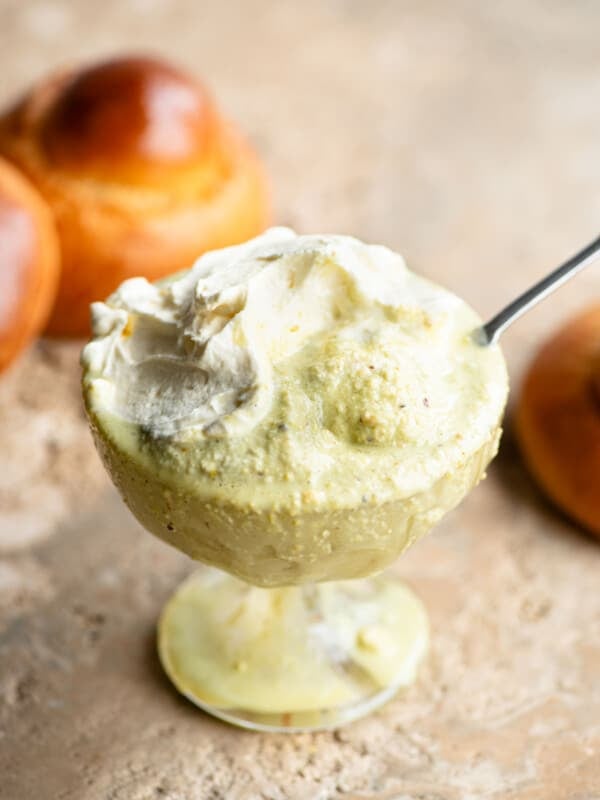Cenci di Carnevale (Chiacchiere, Crostoli, Bugie) Italian Fried Pastries
Updated May 12, 2024, Published Jan 13, 2022
This post may contain affiliate links. Please read our disclosure policy.
Cenci di Carnevale are sweet and crispy Italian fried pastries made and eaten for carnival. They have a beautiful citrus and vanilla aroma, crunchy, bubbly and super light texture and are dusted in powdered sugar before serving. Follow our easy step by step recipe for making these traditional and addictively delicious sweets at home!

Carnevale is always such a fun time in Italy, the celebrations start a couple of weeks before lent. It’s full of costumes, masks and parades, confetti, music, and best of all…delicious food.
Depending on what region you’re in you’ll see these fried pastries with all kinds of different names such as Chiacchiere (which means gossip or chat), Bugie (which means lies), Crostoli (because of their crunchy texture), Frappe (fritters) or Cenci, which is the Tuscan word for rags.
The Cenci are made with a sweet dough that’s rolled paper-thin, cut into rustic rags and deep-fried. They’re then dusted in powdered sugar before serving, crunchy, crispy, sweet and utterly delicious!
Ingredient notes and substitutions

Pin this now to find it later
Pin It- Flour – we used Italian 00 flour which is what’s traditionally used but all-purpose flour will also work.
- Butter – make sure it’s at room temperature (not too cold or melted).
- Sugar – use white caster sugar (superfine) sugar instead of granulated.
- Eggs – make sure to use large eggs or your dough might be too dry.
- Baking soda – also known as bicarbonate of soda.
- Liqueur – you can use pretty much any Italian liqueur you like, we used Tuaca but you can also use Marsala, Strega, Vin Santo or Grappa.
- Orange zest – you can also use lemon zest.
- Sunflower oil – this is what I use for frying, make sure to use a flavourless oil.
- Powdered sugar – (known as icing sugar in the UK) makes such a difference when dusted on top.
Step by step recipe photos
- Step 1 – mix all the dry ingredients together in a bowl. Add the butter and crumb it into the flour (photos 1-4).

- Step 2 – make a well in the centre and add all the wet ingredients, use a fork to incorporate it into the flour until a rough dough forms. Tip onto a clean work surface and knead the dough for 5-10 minutes until smooth and elastic (photos 5-8).

- Step 3 – cut the dough in half, flatten one half so it’ll fit through the widest setting on your pasta machine. Pass it through each setting from the widest (usually number 0) until it’s paper thin (second last setting number 8) (photos 9-12).

- Step 4 – cut the dough into 2 inch wide ribbons using either a knife or fluted pasta wheel and make a slit in the centre of each one. Fry in hot oil for a few seconds on each side until golden. Drain them on kitchen paper, let cool then dust with powdered sugar (photos 13-16).

Flavour options and serving suggestions
You can swap the liqueur, citrus zest and vanilla for different flavours depending on what you have or feel like, see our suggestions below.
- Alcohol options – there are so many different liqueurs you can use such as; grappa, vin santo, strega, tuaca, marsala or simply white wine which may be a cheaper option if you don’t already have one of those.
- Citrus zest – orange or lemon zest add a wonderful flavour.
- What you can use instead of vanilla – if you fancy experimenting with different flavours you could swap the vanilla for almond, rum or orange extract.
Serving suggestions
Traditionally cenci are simply dusted in a vanilla flavoured powdered sugar although that can be hard to find outside of Italy so regular powdered sugar is fine.
In Emilia-Romagna they are drizzled with Alchermes liqueur before serving, this stains them a pretty pink colour. This liqueur is also used to make Zuppa Inglese another delicious Italian dessert.
Another option is to drizzle them with chocolate or melted chocolate hazelnut spread.

Top tips and recipe FAQs
- Don’t let them burn – these Italian pastries fry very quickly (in a matter of seconds). Drop them in then when they start to puff up flip them over for a few seconds then remove them from the oil.
- Drain on kitchen towels – it’s really important to drain the cenci on kitchen towels so they stay crisp and don’t taste too oily.
- keep the dough covered – I roll out one half of the dough at a time and make sure the other half of the dough is wrapped up in cling film to stop it from drying out. Also try not to use too much flour when rolling out (just enough so it doesn’t stick).
- Fry with caution – always take great care when frying with hot oil. Use a heavy based pot so it can’t be knocked over easily and never leave it unattended.
Yes, you can make the dough in a stand mixer using a dough hook attachment.
If you don’t have a pasta machine you can roll the dough out by hand using a rolling pin just try to roll the dough out as thin as possible.
If you have a thermometer heat the oil to around 190C (375F). If not, test a small piece of dough, if it floats and lots of little bubbles surround it and turns golden in a few seconds the oil is ready. Keep an eye on the temperature as you go.
The Cenci will keep well for up to 5-7 days (possibly longer). Store them in cool dry place. Dust with powdered sugar before serving.
What is Italian Carnivale and when is it celebrated?
The official date of Carnevale is Fat Tuesday or Martedi Grasso (known in the US as Mardi Gras). It’s the day before Ash Wednesday where the period of Lenten begins which involves giving up indulgent foods and fasting.
In Italy, the celebrations for Carnevale start a couple of weeks before Fat Tuesday with parades, music, masks, costumes, confetti and lots of fried treats and desserts.
More traditional Italian desserts to try
- Italian Easter Bread (Pane di Pasqua)
- Apple Crostata with Apricot Jam
- Struffoli – Italian Honey Balls
- Homemade Sicilian Cannoli (shells and filling)
- Bomboloni – Italian Doughnuts
If you’ve tried this Cenci recipe or any other recipe on the blog then don’t forget to rate the recipe and let me know how you got on in the comments below, I love hearing from you! You can also FOLLOW US on FACEBOOK, INSTAGRAM and PINTEREST or sign up to our NEWSLETTER to see more of our delicious food.
Step By Step Photos Above
Most of our recipes come with step by step photos, helpful tips and tricks to make it perfectly first time and even video!
Cenci di Carnevale (Italian fried pastries for carnival)

Equipment
- Pasta machine or rolling pin
- Plastic wrap (cling film UK)
Ingredients
- 2 cups* Italian 00 flour, *spooned and leveled (280g)
- 2 tablespoons caster sugar (superfine), (30g)
- 1 teaspoon baking soda, (bicarbonate of soda UK)
- Zest of 1 orange or lemon
- 2 tablespoons butter, at room temperature (30g)
- 2 large eggs
- 1 teaspoon vanilla extract
- 1 tablespoon Italian liqueur , such as Marsala, Tuaca, Strega, Grappa or Vin Santo
- ½ teaspoon fine salt
- 1-2 tablespoons powdered sugar, for dusting (icing sugar UK)
- Sunflower oil, for frying
Instructions
To make the dough
- Put the flour, sugar, baking soda, salt and orange zest in a bowl and stir until fully combined. Add the butter and crumb it into the flour using your hands until it resembles breadcrumbs. Make a well in the centre of the flour for the liquids.
- In a small bowl mix the eggs, vanilla and liqueur together. Pour them into the flour mixture and stir to combine everything together with a fork.
- Once a rough dough starts to form, use your hands to knead it for 5-10 minutes until smooth and elastic. Wrap it in plastic wrap and leave it to rest for 30 minutes.
Rolling out
- Once rested, cut the cenci dough in half (wrap one half back up in plastic wrap). Flatten the piece of dough so it’s thin enough to fit through the widest setting on your pasta machine.
- Sprinkle your work surface and pasta machine with a little flour. Pass the dough through the widest setting then continue to pass the dough through your machine whilst going up one number at a time until the dough is almost paper-thin. You may need to cut the dough in half if it gets too long so it’s easier to manage.
- On most pasta machines number 0 is the widest setting and number 9 is the thinnest. I go up to number 8. The thinner the dough the crispier your cenci will be.
- Using a knife of fluted pasta cutter cut the cenci into strips about 2 inches wide then cut a slit in the middle of each one making sure not to cut all the way to the edges. This is a traditional way of cutting them but you can cut them into any rough shape you like.
Frying
- Heat the sunflower oil in a large heavy-bottom based pan, the oil should be around 2 inches deep.
- If you have a sugar thermometer it should be around 180-190C (350-375F). If not test a small piece of dough, if lots of bubbles surround the dough and it turns golden within a few seconds, the oil is ready.
- Fry the cenci in batches for a few seconds on each side until golden brown and bubbly. Drain them on kitchen paper as you go.
- Once cooled, arrange them on a serving plate and dust with powdered sugar.
Video
Notes
- Measuring flour – if using cups make sure to spoon the flour into the cup and level it off with a knife otherwise you may over measure the flour. As always a kitchen scale will ensure accurate results every time.
- Drain on kitchen towels – it’s really important to drain the cenci on kitchen towels so they stay crisp and don’t taste too oily.
- keep the dough covered – I roll out one half of the dough at a time and make sure the other half of the dough is wrapped up in cling film to stop it from drying out. Also try not to use too much flour when rolling out (just enough so it doesn’t stick).
- Fry with caution – always take great care when frying with hot oil. Use a heavy based pot so it can’t be knocked over easily and never leave it unattended.
- Storage – the cenci will keep well for 5-7 days. Store in a cool, dry place.
Helpful Info for All Recipes
- I always use extra virgin olive oil in all of my recipes unless stated otherwise
- When I use canned or jarred tomatoes of any kind I always use Cirio or Mutti brands for the best results and flavour.
- All vegetables are medium sized unless stated otherwise
- All recipes are tested and developed using a fan (convection) oven
- Find out more about how nutrition is calculated.
- Check out our must have Italian Pantry Staples.
- You can also find all our Essential Kitchen Tools for Italian Cooking.
Nutrition
Nutrition information is automatically calculated, so should only be used as an approximation.













Thank you so much for sharing these recipes for struffoli and cenci strips. In a hurry I accidently left my recipe for them back East, when I moved out West. I have not made them as yet, I always tried to make them for the holidays, just like my Italian mama did.
Your recipe includes butter but it’s not in the steps. Is it melted and added with the liquid?
Ah sorry, thank you for noticing that! The butter is soft (room temperature) and crumbed into the flour before adding the liquids. I’ve just added that into the recipe, the step by step photos in the post show that step too 🙂